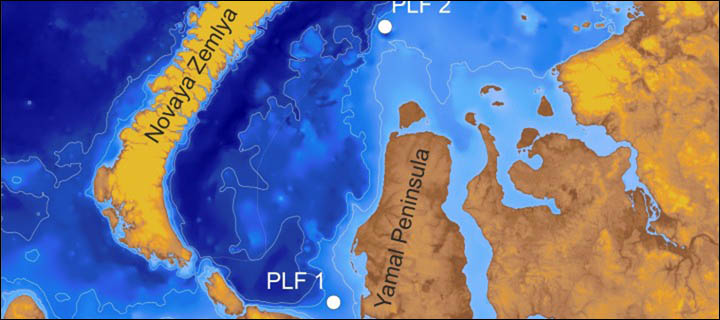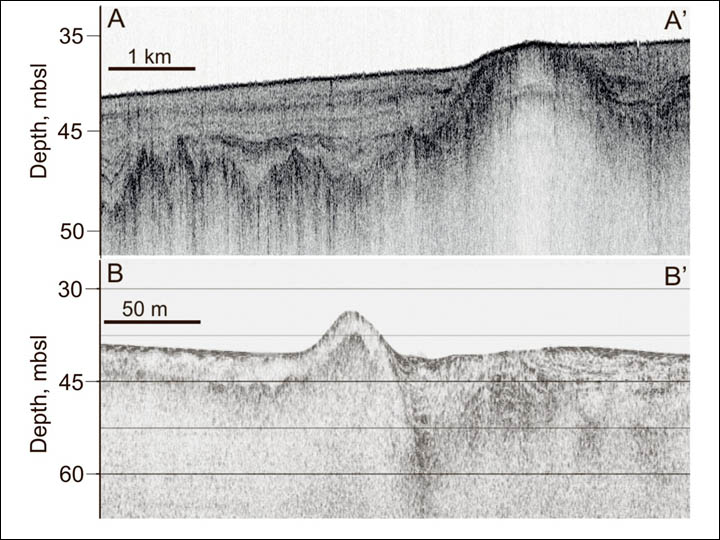Environment & Energy
Related: About this forumArctic Ocean Pingoes May Pose Same Methane Blowout Risk As Siberian Land Craters
uge attention has focused on the mysterious large holes that have suddenly appeared in the Siberian Arctic recently, and now there is evidence of a similar process underwater in southern areas of the Kara Sea. Large mounds - described as pingos - have been identified on the seabed off the Yamal Peninsula, and their formation is seen as due to the thawing of subsea permafrost, causing a 'high accumulation' of methane gas.
These mounds 'are leaking methane' and their 'blowout potential' poses a significant 'geohazard' to energy exploration in Arctic waters, according to new research by scientists at Centre for Arctic Gas Hydrate, Environment and Climate (CAGE) in Norway, supported by the Federal Subsoil Resources Management Agency of Russia.

Two subsea pingos that were identified offshore (of) the very same area of the mysterious Yamal peninsula craters. Picture: Pavel Serov
EDIT
Dr Pavel Serov, lead author of the research which is published in the Journal of Geophysical Research, said: 'Pingos are intensively discussed in the scientific community especially in the context of global climate warming scenarios. They may be the step before the methane blows out.' The researchers focused on 'two subsea pingos that were identified offshore (of) the very same area of the mysterious Yamal peninsula craters', reported the CAGE website. The Siberian Times has led the way in drawing attention to the land craters, publishing the views of scientists on their formation and spectacular pictures of the giant holes taken during expeditions to the new phenomena. After initial doubts, scientists now believe the craters were formed by pingos erupting under pressure of methane gas released by thawing of permafrost caused by warming temperatures.


This is the view of the subsea pingo features as the scientists see them. Pictures: Pavel Serov
The underwater mounds were between 70 metres and 1,000 metres in diameter, and had been spotted originally on a seismic study of the area. They rise between five and nine metres above the surrounding sea floor. In overall size they are considerably larger than those found on land in Yamal. Dr Serov said: 'Our question was: Are these mounds submerged terrestrial pingos? Or are they something different forming under marine conditions? One of the South Kara Sea pingos was leaking a lot of methane but where was the methane coming from?' As permafrost extends into the ocean so do the pingos,' said a synopsis of the research for CAGE written by Maja Sojtaric. 'They even appear in geographical proximities to the ones observed on land.'
Initially it was thought the undersea pingos were 'relics of the Ice Age', but the groundbreaking new research indicates the reverse, indicated CAGE director Professor Jurgen Mienert, a co-author of the paper. 'The CAGE study shows these newly discovered subsea pingos may be quite recent.' Crucially, 'gas leakage from one of the ocean floor pingos offshore (of) Siberia shows a specific chemical signature that indicates modern generation of methane', state the researchers. 'We suggest that the mound formed more recently, moving material physically upwards.' Likewise the processes leading to methane eruptions on the neighbouring peninsula are seen as very recent.
EDIT
http://siberiantimes.com/science/casestudy/features/f0183-leaking-pingos-can-explode-under-the-sea-in-the-arctic-as-well-as-on-land/
earthside
(6,960 posts)If the worst case scenario of global warming is going to happen, these possible pingoe methane 'leaks' are primary indicators.
Read Guy McPherson (recently featured by Bill Nye on National Geographic's Explorer TV show):

Climate-Change Summary and Update
http://guymcpherson.com/2014/01/climate-change-summary-and-update/